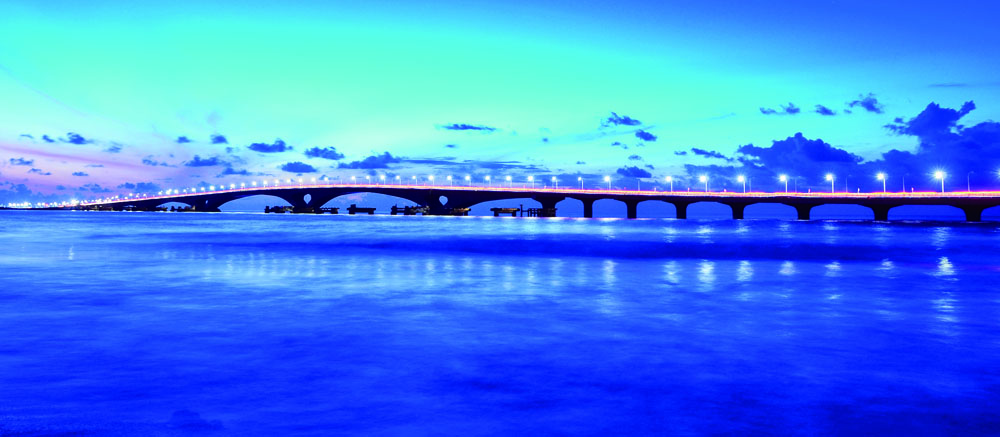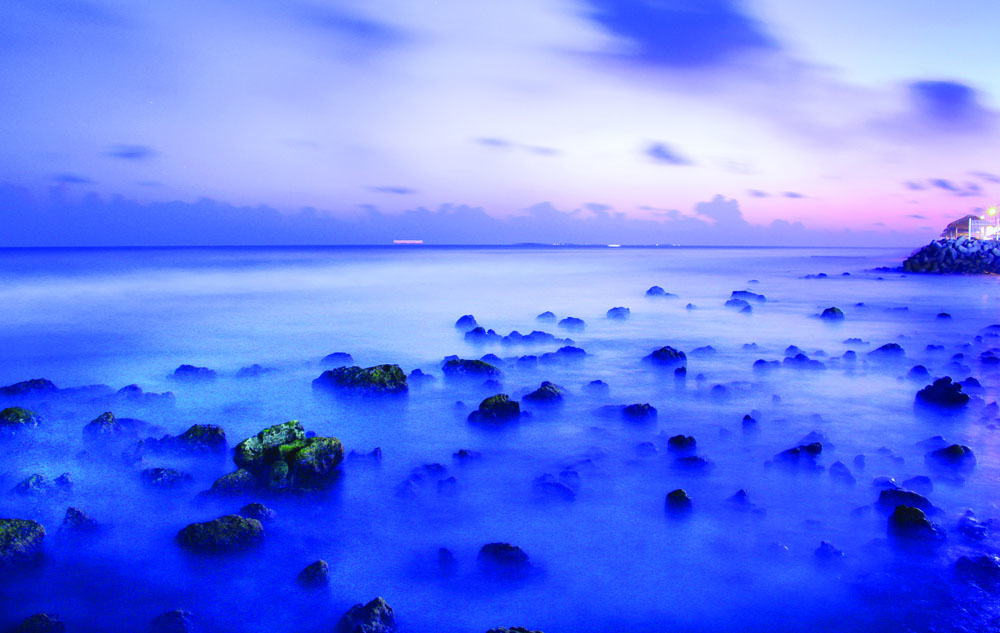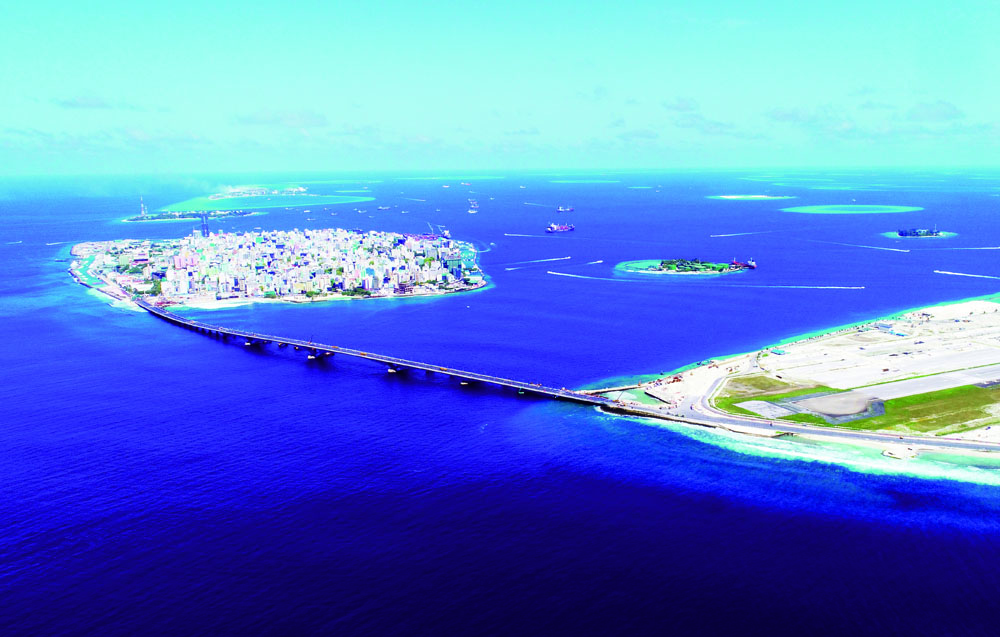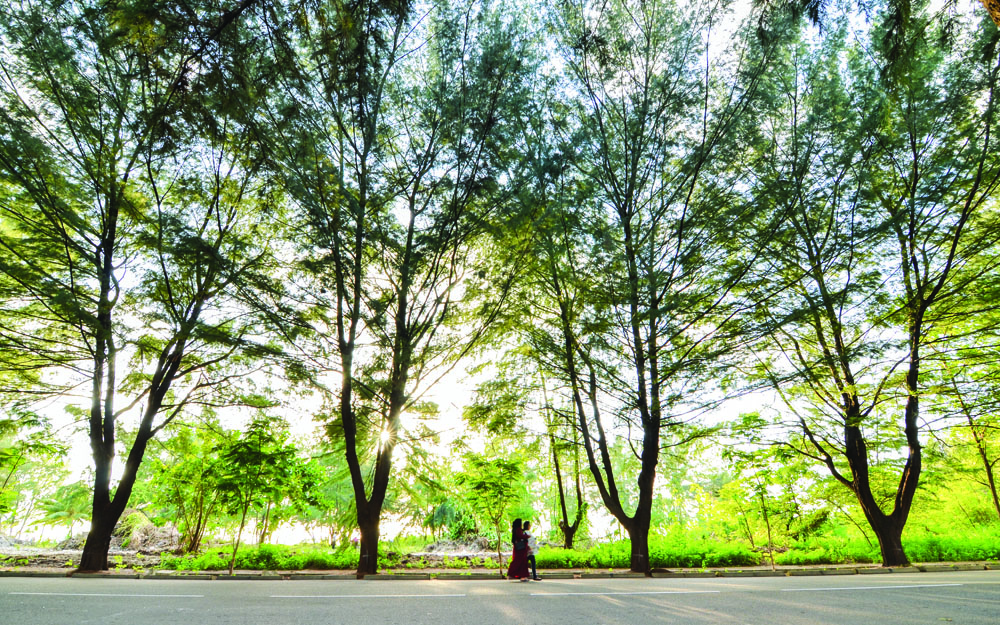Maldives' Bridge of Dreams
By Lu Jie, Du Cailiang
[Maldives] Hussain Thasneem
On the evening of a hot summer day in August 2018 in the Maldives, brilliant fireworks lit up the sky over Male Island, the Maldivian capital, as the entire country celebrated the opening of the China-Maldives Friendship Bridge.

It is the first cross-sea bridge in the Maldives, an archipelago of over 1,000 islands. The 2-kilometer bridge connects Male with Hulhule Island, where the Male International Airport is located.
“The China-Maldives Friendship Bridge is a symbol of the long-term friendship between the two countries, and a milestone in the China-Maldives friendship,” then Maldivian President Abdulla Yameen said at the opening ceremony. “We appreciate the assistance provided by the Chinese government, which has made the dream of the Maldivian people a reality.”

The China-Maldives Friendship Bridge at dusk
Treasure Island’s Dream
The Maldives was known as “Treasure Island” from the 10th century. It was a port of call for Arab and Persian traders traveling on the ancient Silk Road, who took the archipelago’s pearls, agate, spices, coconut and dried fish to the rest of the world. Cowrie shells, which abounded on the islands, were one of the currencies used in international trade at that time. In the 15th century, Zheng He, the famous Chinese navigator of the Ming Dynasty (1368-1644) who made seven voyages around the Indian Ocean, then known as the Western Seas, stopped over in the Maldives twice. He called it Liushan, meaning a country of underwater mountains in Chinese. His entourage included Ma Huan, whose book Yingya Shenglan (An Overall Survey of the Ocean’s Shores) was a vivid record of the local customs and practices of the countries the group visited.
“There are countless islands facing the sea on all sides,” Ma wrote of the Maldives. “Most of the locals depend on fishing for a living. The seafood produced is exported to India, Siam and other countries.” He also wrote that the Sultan of the Maldives warmly welcomed Zheng He’s fleet and sent his people to sail with them to further destinations to learn about trading and technology. Since then with the passage of time, there have been sweeping changes worldwide.
The Maldives became renowned as a beautiful global tourist destination. The Greater Male where Male, Hulhule and Hulhumale are located became a hub of activities. However, the islands were connected only by ship and seaplane, making it difficult to realize the full socioeconomic potential of the country.
The Maldivians dreamed of a cross-sea bridge that would connect the major islands and help the “Pearl of the Indian Ocean” shine brighter.

Sunset in the Maldives
However, it was costly to build a cross-sea bridge on the coral reefs. It was also challenging in terms of technological expertise. Maldivians had to keep their dream to themselves.
“When China agreed to assist the Maldives in building a cross-sea bridge, they could hardly believe that their dream was about to come true.
From the start of construction to opening the bridge to traffic, it took two years and eight months. In those 975 days and nights, the engineers and construction workers on the job worked assiduously on the site, oblivious to the scorching sun or heavy downpours.
As the bridge made its way to the other side of the sea steadily, Maldivians felt their dream was coming true with each passing day.
Connectivity Makes Life Better
When the bridge was completed and about to open to traffic, there was great excitement on the islands.
Early in the morning, hundreds of motorcycles gathered at the gate of the bridge. Private cars, taxis and minivans also arrived in large numbers. At the intersections, policemen were busy maintaining order. It was a spectacular sight. Everyone was looking forward to the “maiden ride” with palpable excitement.
When finally the traffic light turned green, the crowds flocked to the bridge and the gate to a better life opened.
In the first days after the bridge was opened, exultant motorcyclists would ride between its two ends over and over again to enjoy the ride. Young people on motorcycles, young couples and kids in cars, or business people in minivans, everyone who rode on the bridge showed genuine joy.

Maldivians enjoy their first ride on the China-Maldives Friendship Bridge on its inauguration
Maldives has a romantic nickname, “A Necklace of Exquisitely Beautiful Pearls Created by God”. The China-Maldives Friendship Bridge has added to the splendor of the necklace.
The bridge has touched the life of Marsha, a 17-year-old who goes to the Villa Middle School on Male. Since she lives on Hulhumale, Marsha had to take the ferry to travel between the two islands.
On rainy and windy days the strait between the islands could turn dangerous with billowing waves. What should have been a regular journey to school became an indescribably difficult hardship. Marsha had a lot to say about the old days: “I was often late. The school starts at 8 a.m. Even if I got up at 5, sometimes I couldn’t make it to class in time.”
But since the bridge opened, Marsha and her schoolmates no longer have to worry about being late. Nor do they have to worry about bad weather. The “bitter journey” that used to take two to three hours has become a joyride of minutes on her father’s motorcycle. The cross-sea bridge has improved the traffic in Greater Male as well.
The local authorities are running a special bus service with nine brand new buses shuttling on the bridge every day. The daily 52 services at 20-minute intervals can transport up to 7,000 passengers. In the future, the number of buses will increase to 22, connecting Male and Hulhumale more closely.
“We could never have expected this,” commented Male resident Hardie, who was riding a bus with his 3-year-old son, with the tot enjoying the view outside. “It is now easy to take him to the park on the other island,” he added, “It used to be so inconvenient earlier.”
“Youth Island” Gets New Vitality
Hulhumale is a well-known artificial island. It is also the Maldives’ largest island, known affectionately as “Youth Island”. The bridge has given impetus to its economic development.

A bird's-eye view of the China-Maldives Friendship Bridge
On a sunny day when the sky was as blue as the sea, 23-yearold Hussain was on the bridge in his minivan, enjoying the fresh sea breeze. The sales manager of a hardware accessories company, Hussain travels between Male and Hulhumale several times every day. This seemingly ordinary journey had been a dreadful ordeal in the past.
“We were once delivering some spare parts to Hulhumale,” Hussain recalled. “We had to wait for the ferry for more than five hours!”
“After the bridge opened, we have been saving at least 70 percent of our transportation cost. It’s no problem now to make four or five round trips a day. Our business on Hulhumale Island is growing steadily.”
“The Chinese were so good at building the bridge,” he added.
“We really appreciate what they have done for us!”
The Flying Fish restaurant on Hulhumale is also doing brisker business. “After the bridge opened, there has been a big increase in the number of our customers,” said Geis, headwaiter at the Flying Fish. “In the first month, we saw a 30-percent jump. On weekends especially, many Male residents came to join the queue of diners. We have been very busy.” “Some Male customers also call us to order takeaways and show up on their motorcycles soon afterward for the food,” Geis added.
Hulhumale Island is a balmy and romantic place with its sea breeze, the murmur of waves and swaying coconut trees. After a busy day, people head there to enjoy their leisure hours in the evening. “The bridge has made our coffee bar more popular,” 34-yearold manager Arman said with a thumbs-up. “Even at midnight, our customers from Male are in no hurry to go home. The bridge is marvelous!”
The bridge has opened the traffic arteries of Greater Male, making the flow of people and goods smoother. On Hulhumale, the central district is chock-a-block with shops and businesses, showing signs of unprecedented prosperity.
As night falls, there is still busy traffic on the bridge illuminated with bright lights. It is a surge of vitality.
Joining Hands to Realize a Dream
The long-wished-for bridge attracted a lot of attention from the Maldivian society from the very onset of its construction. To ensure smooth progress of the project, the Maldivian government provided a lot of support, including forming a project coordination committee led by the Office of the President.

A tree-lined avenue on Hulhumale Island
Maldives’ Minister of Housing and Urban Development at the time made on-site inspections of the bridge every month. Local schools and media organized various forms of visits, exchanges and interviews. To enable people to watch the bridge coming up, the government urged to build a viewing platform next to the bridge. During the two plus years of construction, it became almost a daily routine for the local people to watch the bridge from there with curiosity and expectation.
The builders of the bridge lived up to the support and expectation. In the ultra-short period of construction, they overcame a stream of challenges. They explored the best operational plan for the complex geological environment of coral reefs. They looked for “windows” for construction in the face of the strong surging waves. They remained at their post even during an outbreak of dengue fever. They explored new craftsmanship, new materials and new technology in an environment of high temperature, salinity and corrosion. They overcame all the difficulties to help the Maldives realize its dream of crossing the strait by land by building a modern and magnificent bridge on the Indian Ocean with a life span of 100 years. The bridge also bears witness to the friendship between the two countries.
“This bridge has realized a century-old dream of the Maldivian people,” octogenarian former Maldivian Minister of Housing and Urban Development Umar Zahir said when he visited the bridge.
“While other countries told us that it would be an impossbile mission [to build such a bridge], it was the Chinese construction team that ultimately made our dream a reality.”
FOR MORE
Project Overview
The China-Maldives Friendship Bridge is a 2-kilometer cross-sea bridge connecting Maldivian capital Male with Hulhule Island, where the international airport is located. The project consists of the bridge, crossstrait wiring works, auxiliary facilities along the line, landscape works, bridge navigation aids and municipal pipeline accesses.
The main bridge, with a total length of 760 meters, is a six-lane, composite-beam, V-shaped rigid frame bridge. It has been built with Chinese assistance, with CCCC (China Communications Construction Company) Highway Consultants Co., Ltd. managing the project and CCCC Second Harbor Engineering Co., Ltd. as the engineering, procurement and construction contractor.
The bridge has realized cross-sea connection between Male and other islands for the first time in the history of the Maldives, greatly facilitating travel and boosting the economic development of Greater Male.


